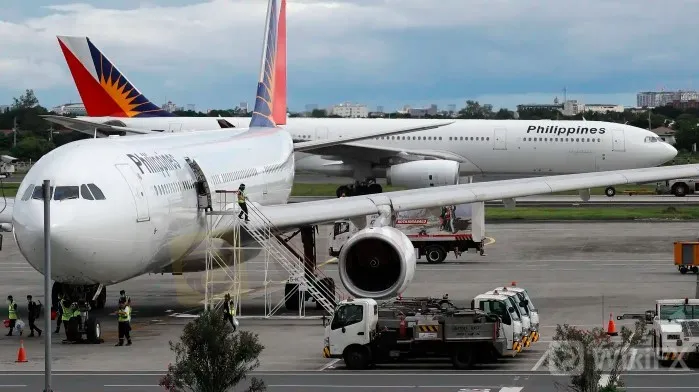简体中文
繁體中文
English
Pусский
日本語
ภาษาไทย
Tiếng Việt
Bahasa Indonesia
Español
हिन्दी
Filippiiniläinen
Français
Deutsch
Português
Türkçe
한국어
العربية
Philippine Airlines parent begins trading
Abstract:Flag carrier aims to take off with more cargo and digitized operations
Philippine Airlines' parent company began trading on Monday but needs more funding. MANILA Philippine Airlines' parent company began trading on Monday, nine months after exiting bankruptcy protection. MANILA Philippine Airlines' financial difficulties worsen even as its parent company believes it is nearing completion of a debt restructuring plan. PAL Holdings recorded a financial loss of 8.6 billion pesos ($178 million) for the three months ended March, while its capital deficit increased by over 10 billion pesos to 83.9 billion pesos. The carrier is “in the final phases of a comprehensive restructuring plan that will enable the airline to emerge financially stronger from the current global crisis,” according to a press release accompanying the findings. The company's 2020 results showed the pandemic's impact. In 2019, the net loss grew to 73 billion pesos from 9.7 billion, while revenues fell 64% to 55.3 billion. Its capital deficit increased to 74 billion pesos from 3.5 billion pesos in 2019. President Gilbert Santa Maria announced late last year that the corporation would seek legal protection for its debt restructuring. It also planned to return planes to lessors and raise $505 million in new finance to avoid bankruptcy. Early this year, the corporation laid off roughly 2,000 people, or a third of its workforce. In its 2020 annual report, Philippine Airlines said it had already begun reorganizing its fleet to accommodate lower demand for air travel. On May 26, it had not submitted “any rehabilitation plan with any court”. The airline will also streamline its route network by discontinuing “certain ultra-long-haul routes and modifying overall route network frequencies” compared to 2019. According to PAL Holdings, it has received “bridge money and support from its majority shareholder and deferred payments through the forbearance of lessors, lenders, and suppliers.” “Philippine Airlines' recovery will be slow,” PAL Holdings said. “The situation remains uncertain, but the availability of COVID-19 vaccination gives hope that passenger traffic will surpass 2020.” All Nippon Airways' parent firm, ANA Holdings, owns 9.5% of PAL Holdings.

Disclaimer:
The views in this article only represent the author's personal views, and do not constitute investment advice on this platform. This platform does not guarantee the accuracy, completeness and timeliness of the information in the article, and will not be liable for any loss caused by the use of or reliance on the information in the article.
Read more

Should You Beware of Forex Trading Gurus?
Know the reality behind forex trading gurus, examining their deceptive tactics, inflated promises, and the risks associated with trusting them for financial advice.

Why More People Are Trading Online Today?
Discover why online trading is booming with tech, AI, and a push for financial freedom. From stocks to crypto, it’s a thrilling hustle for all.

High Return Traps? WikiFX’s Complete Scam-Busting Handbook to Avoid Financial Fraud!
Financial scams are evolving faster than ever, and fraudsters are getting more creative in luring victims into traps. Whether it’s promising high returns or leveraging authority to build trust, scammers continuously innovate new ways to trick investors. From clone firms to cold calling schemes, it’s essential to understand how these scams work to protect your hard-earned money. This comprehensive guide by WikiFX will help you recognize and avoid common financial scams.

Forex Explained in 60 Seconds: How It Works & Who Profits
Before diving into the forex market, it’s crucial to understand its mechanics, risks, and profit potential. Without a clear grasp of how forex operates, you risk losing money instead of making it. Here’s a concise breakdown to help you navigate this dynamic financial market.
WikiFX Broker
Latest News
TradingView Brings Live Market Charts to Telegram Users with New Mini App
Trump tariffs: How will India navigate a world on the brink of a trade war?
Interactive Brokers Launches Forecast Contracts in Canada for Market Predictions
Authorities Alert: MAS Impersonation Scam Hits Singapore
Stocks fall again as Trump tariff jitters continue
INFINOX Partners with Acelerador Racing for Porsche Cup Brazil 2025
Regulatory Failures Lead to $150,000 Fine for Thurston Springer
April Forex Trends: EUR/USD, GBP/USD, USD/JPY, AUD/USD, USD/CAD Insights
March Oil Production Declines: How Is the Market Reacting?
Georgia Man Charged in Danbury Kidnapping and Crypto Extortion Plot
Currency Calculator







